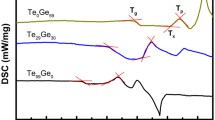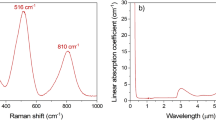Abstract
In this work, reduced graphene oxide-coated zinc borotellurite doped with erbium oxide nanoparticles denoted as ZBTEr (NPs)-rGO was studied as an approach to enhance the optical properties of glass materials. Herein, a melt-quenched technique was used to prepare the ZBTEr (NPs) glasses. A simple and inexpensive spray-coated technique was employed to deposit the rGO onto the glass surfaces directly. The morphological studies of ZBTEr (NPs)-rGO glass surfaces were investigated by scanning electron microscope (SEM) and high-resolution transmission electron microscopy (HR-TEM) meanwhile, the structural investigation of ZBTEr (NPs) glasses was revealed by X-ray diffraction (XRD) and Raman analysis. The morphological analysis revealed the residual oxygen groups functionalized on ZBTEr (NPs)-rGO glass surfaces meanwhile, TEM images confirmed the presence of Er (NPs) in the glassy matrix. The glass samples showed the existence of structural disorder and amorphous nature. The absorption spectra presented the transition bands that existed from 4I15/2 ground state level to excited state levels of 2H9/2, 4F5/2, 4F7/2, 2H11/2, 4S3/2, 4F9/2, 4I11/2, and 4I9/2, respectively. Judd–Ofelt analysis was performed to obtain the intensity parameters (Ωλ), radiative transition (A), branching ratios (βR), and radiative lifetimes (tr). The radiative parameter and branching ratio values suggested the higher stimulated emission radiative at 2H11/2 → 4I15/2 transition for present glass The luminescence spectra exhibited two emission peaks centred at 539 nm and 558 nm which were assigned to 2H11/2 → 4I15/2 and 4S3/2 → 4I15/2 transitions, respectively. The optical results for ZBTEr (NPs)-rGO and ZBTEr (NPs)-uncoated were compared to determine the differences between coated and uncoated glasses. These results highlight the significant effect of rGO deposited onto tellurite-based glass and thus, this work proposed the potential coating materials for improving current fiber optics.











Similar content being viewed by others
Data availability
The authors declare that the data supporting the findings of this study are available within the article.
References
A.K. Geim, K.S. Novoselov, The rise of graphene. Nat. Mater. 6(3), 183–191 (2007)
N. Sharma, M. Arif, S. Monga, M. Shkir, Y.K. Mishra, A. Singh, Investigation of bandgap alteration in graphene oxide with different reduction routes. Appl. Surf. Sci. 513, 145396 (2020)
A. Afroozeh, Dependence of linear and non-linear optical properties to sp3 domains level and edges length in graphene-based nanomaterials. Optik (Stuttg) 226, 165903 (2021)
I. Papadakis, A. Bakandritsos, A.K. Swain, T. Szabo, S. Couris, Effects of size and oxidation on the nonlinear optical response and optical limiting of graphene oxide sheets. J. Phys. Chem. C 124, 11265–11273 (2020)
M.I. Necolau, A.M. Pandele, Recent advances in graphene oxide-based anticorrosive coatings: An overview. Coatings 10, 1149 (2020)
X. Gao et al., Humidity-sensitive macroscopic lubrication behavior of an as-sprayed graphene oxide coating. Carbon NY. 140, 124–130 (2018)
M. Wang, Z. Li, K. Hou, J. Wang, S. Yang, Balancing oxygen-containing groups and structural defects for optimizing macroscopic tribological properties of graphene oxide coating. Appl. Surf. Sci. 516, 146122 (2020)
S. Azizighannad, S. Mitra, Stepwise reduction of graphene oxide (GO) and its effects on chemical and colloidal properties. Sci. Rep. 8, 10083 (2018)
R. Tarcan, O. Todor-Boer, I. Petrovai, C. Leordean, S. Astilean, I. Botiz, Reduced graphene oxide today. J. Mater. Chem. C 8, 1198–1224 (2020)
X. Shen, G. Cheng, L. Zhang, W. Wei, Fabrication of a hybrid-cladding tellurite glass fiber doped with Tm3+ and Ho3+. J. Lumin. 227, 117540 (2020)
N. Effendy, H.A.A. Sidek, M.K. Halimah, M.H.M. Zaid, Enhancement on thermal, elastic and optical properties of new formulation tellurite glasses: influence of ZnO as a glass modifier. Mater. Chem. Phys. 273, 125156 (2021)
T.M. Machado, R.F. Falci, I.L. Silva, V. Anjos, M.J.V. Bell, M.A.P. Silva, Erbium 1.55μm luminescence enhancement due to copper nanoparticles plasmonic activity in tellurite glasses tamires. Mater. Chem. Phys. 224, 73–78 (2019)
N. Ding, J. Diao, D. Zhang, T. Zheng, J. Lv, Spectroscopic properties of Yb3+ and Nd3+ co-doped tellurite glass for 1.0 μm laser application. Ceram. Int. 46, 25633–25637 (2020)
N.L. Amiar Rodin, M.R. Sahar, Erbium doped sodium magnesium boro-tellurite glass: stability and Judd-Ofelt analysis. Mater. Chem. Phys. 216, 177–185 (2018)
M.K. Halimah et al., Effect of erbium nanoparticles on structural and spectroscopic properties of bio-silica borotellurite glasses containing silver oxide. Mater. Chem. Phys. 236, 121795 (2019)
M. Fang et al., Preparation of highly conductive graphene-coated glass fibers by sol-gel and dip-coating method. J. Mater. Sci. Technol. 35(9), 1989–1995 (2019)
U. Ishtiaq, A. Aref, A.S. Muhsan, A. Rashid, S.S. Hamdi, High strength glass beads coated with CNT/rGO incorporated urethane coating for improved crush resistance for effective hydraulic fracturing. Prod. Technol. Pet. J. Explor. (2022). https://doi.org/10.1007/s13202-022-01468-3
R. Al-Gaashani, A. Najjar, Y. Zakaria, S. Mansour, M.A. Atieh, XPS and structural studies of high quality graphene oxide and reduced graphene oxide prepared by different chemical oxidation methods. Ceram. Int. 45, 14439–14448 (2019)
H.P. Mungse, O.P. Khatri, Chemically functionalized reduced graphene oxide as a novel material for reduction of friction and wear. J. Phys. Chem. C 118(26), 14394–14402 (2014)
G. Greenwood, The growth of dispersed precipitates in solutions. Acta Metall. 4(3), 243–248 (1956)
I. Bulus, R. Hussin, S.K. Ghoshal, A.R. Tamuri, S.A. Jupri, Enhanced elastic and optical attributes of boro-telluro-dolomite glasses: Role of CeO2 doping. Ceram. Int. 45, 18648–18658 (2019)
N. Sharma, S. Tomar, M. Shkir, R. Kant Choubey, A. Singh, Study of optical and electrical properties of graphene oxide. Mater. Today Proc. 36, 730–735 (2019)
W. Liu, G. Speranza, Tuning the oxygen content of reduced graphene oxide and effects on its properties. ACS Omega 6(9), 6195–6205 (2021)
M.D. Nurhafizah, A.B. Suriani, A. Mohamed, T. Soga, Effect of voltage applied for graphene oxide/latex nanocomposites produced via electrochemical exfoliation and its application as conductive electrodes. Diam. Relat. Mater. (2020). https://doi.org/10.1016/j.diamond.2019.107624
M. Fang, X. Xiong, Y. Hao, T. Zhang, H. Wang, Preparation of highly conductive graphene-coated glass fibers by sol-gel and dip-coating method. J. Mater. Sci. Technol. 35(9), 1989–1995 (2019)
M. Lundie, Z. Sljivancanin, S. Tomic, Electronic and optical properties of reduced graphene oxide. J. Mater. Chem. C 3, 7632–7641 (2015)
S.Y. Marzouk, M.A. Azooz, H.A. El Batal, Judd-Ofelt analysis of spectroscopic measurements of Er3+ doped boro-zincate glasses. J. Mol. Struct. 1243, 130925 (2021)
W.T. Carnall, P.R. Fields, K. Rajnak, Electronic energy levels in the trivalent lanthanide aquo ions. I. Pr3+, Nd3+, Pm3+, Sm3+, Dy3+, Ho3+, Er3+, and Tm3+. J. Chem. Phys. 49(10), 4424–4442 (1968)
H. Wen et al., Thermal, optical characterization and Judd-Ofelt Analysis of Nd3+-Doped BaO-TeO2-B2O3 glasses. Mater. Technol. 53(3), 305–309 (2019)
B.R. Judd, Optical absorption intensities of rare-earth ions. Phys. Rev. 127(3), 750–761 (1962)
C.K. Jørgensen, B.R. Judd, Hypersensitive pseudoquadrupole transitions in lanthanides. Mol. Phys. 8(3), 281–290 (1964)
N.N. Yusof, S.K. Ghoshal, M.N. Azlan, Optical properties of titania nanoparticles embedded Er3+-doped tellurite glass: Judd-Ofelt analysis. J. Alloys Compd. 724, 1083–1092 (2017)
V.G. Maslov, A.I. Svitenkov, V.V. Krzhizhanovskaya, Abnormally high oscillator strengths of the graphene nanoribbons electronic spectrum: quantum chemistry calculations. RSC Adv (2016). https://doi.org/10.1039/C6RA04528F
A. Awang, S.K. Ghoshal, M.R. Sahar, R. Arifin, Gold nanoparticles assisted structural and spectroscopic modification in Er3+-doped zinc sodium tellurite glass. Opt. Mater. (Amst) 42, 495–505 (2015)
Z.A. Said Mahraz, M.R. Sahar, S.K. Ghoshal, Enhanced luminescence from silver nanoparticles integrated Er3+-doped boro-tellurite glasses: Impact of annealing temperature. J. Alloys Compd. 649, 1102–1109 (2015)
C.K. Jørgensen, R. Reisfeld, Judd-Ofelt parameters and chemical bonding. J. Less-Common Met. 93, 107–112 (1983)
S. Bhardwaj, R. Shukla, S. Sanghi, A. Agarwal, I. Pal, Spectroscopic properties of Sm3+ doped lead bismosilicate glasses using Judd-Ofelt theory. Spectrochim. Acta Part A 117, 191–197 (2014)
R. Wan, P. Wang, S. Li, Y. Ma, 2.86 μm emission and fluorescence enhancement through controlled precipitation of ZnTe nanocrystals in DyF3 doped multicomponent tellurite oxyfluoride glass. J. Non. Cryst. Solids 564, 120842 (2021)
M. Iezid et al., Judd-Ofelt analysis and luminescence studies of Er3+ doped halogeno-antimonate glasses. Opt. Mater. (Amst) 120, 111422 (2021)
M.N. Azlan, M.K. Halimah, A.B. Suriani, Y. Azlina, S.A. Umar, R. El-Mallawany, Upconversion properties of erbium nanoparticles doped tellurite glasses for high efficient laser glass. Opt. Commun. 448, 82–88 (2019)
Y. Zhang, L. Xia, X. Shen, J. Li, G. Yang, Y. Zhou, Broadband mid-infrared emission in Dy3+/Er3+ co-doped tellurite glass. J. Lumin. 236, 118078 (2021)
Y. Zhang, L. Xia, C. Li, J. Ding, J. Li, Y. Zhou, Enhanced 2.7 µm mid-infrared emission in Er3+/Ho3+ co-doped tellurite glass. Opt. Laser Technol. 138, 106913 (2021)
Z. Liu, J. She, B. Peng, Spectroscopic properties of Er3+-doped fluoroindate glasses. J. Rare Earths (2021). https://doi.org/10.1016/j.jre.2021.05.011
R.R. Jacobs, M.J. Weber, Dependence of the 4F3/2 → 4111/2 induced-emission cross section for Nd3+ on glass composition. IEEE J. Quantum Electron. 12(2), 102–111 (1976)
A.M. Hamza et al., Structural, optical and thermal properties of Er3+-Ag codoped bio-silicate borotellurite glass. Results Phys. 14, 102457 (2019)
H. Zanane et al., Judd-Ofelt analysis and crystal field calculations of Er3+ ions in new oxyfluorogermanotellurite glasses and glass-ceramics. Opt. Mater (Amst) 100, 109640 (2020)
L. Aarts, S. Jaeqx, B.M. Van Der Ende, A. Meijerink, Downconversion for the Er3+, Yb3+ couple in KPb2Cl—A low-phonon frequency host. J. Lumin. 131, 608–613 (2011)
A.M. Hamza, M.K. Halimah, F.D. Muhammad, K.T. Chan, Physical properties, ligand field and Judd-Ofelt intensity parameters of bio-silicate borotellurite glass system doped with erbium oxide. J. Lumin. 207, 497–506 (2019)
K. Maheshvaran, S. Arunkumar, V. Sudarsan, V. Natarajan, K. Marimuthu, Structural and luminescence studies on Er3+/Yb3+ co-doped boro-tellurite glasses. J. Alloys Compd. 561, 142–150 (2013)
J.G. Câmara, D.M. da Silva, L.R.P. Kassab, C.B. de Araújo, A.S.L. Gomes, Random laser emission from neodymium doped zinc tellurite glass-powder presenting luminescence concentration quenching. J. Lumin. 233, 117936 (2021)
M.N. Azlan, M.K. Halimah, S.O. Baki, D.W. Mohamad, Green emission of tellurite based glass containing erbium oxide nanoparticles. J. Nanomater. (2015). https://doi.org/10.1155/2015/952308
Acknowledgements
The authors extend their appreciation to the Deanship of Scientific Research at King Khalid University, Saudi Arabia for funding this work through Large Groups Project under grant number L.R.G.P/174/43. The authors express their gratitude to Princess Nourah bint Abdulrahman University Researchers Supporting Project number (PNURSP2022R26), Princess Nourah bint Abdulrahman University, Riyadh, Saudi Arabia. This research was financially supported by Skim Geran Penyelidikan Fundamental (FRGS) Fasa 1/2018 (Grant code: 2019-0006-102-02). The authors would like to thank the following institutions for equipment support: Faculty of Science and Mathematics, Universiti Pendidikan Sultan Idris.
Funding
The funding was provided by Deanship of Scientific Research, Princess Nourah Bint Abdulrahman University, PNURSP2022R26, Azlan M.N
Author information
Authors and Affiliations
Contributions
YA., (write the research article), MNA, (supervise the methodology and data analysis), ABS, (produce the graphene oxide), HRS (determine the glass composition), IB, (characterize the XRD analysis), IK, (characterize the UV–visible spectra), NA-H, (characterize the FESEM analysis), SAU, (analyze the UV–Visible spectra), KB. K, (determine optical band gap), MHMZ., (determine the refractive index), HR., (assists the graphene oxide production), SMI, (assists the spray coating technique), SNN, (determine Judd–Ofelt analysis), NNY, (fabricate the glass samples) KMK, (determine the luminescence analysis), ZAA., MSA-B (analyze optical data), RAT (determine the RAMAN analysis), FF (analyze the structural and morphological analysis).
Corresponding author
Ethics declarations
Conflict of interest
The authors declare that they have no known competing financial interests or personal relationships that could have appeared to influence the work reported in this paper.
Additional information
Publisher's Note
Springer Nature remains neutral with regard to jurisdictional claims in published maps and institutional affiliations.
Rights and permissions
Springer Nature or its licensor (e.g. a society or other partner) holds exclusive rights to this article under a publishing agreement with the author(s) or other rightsholder(s); author self-archiving of the accepted manuscript version of this article is solely governed by the terms of such publishing agreement and applicable law.
About this article
Cite this article
Azlina, Y., Azlan, M.N., Suriani, A.B. et al. Emission properties of reduced graphene oxide-coated Er3+-tellurite glass for fiber optics. J Mater Sci: Mater Electron 33, 26915–26930 (2022). https://doi.org/10.1007/s10854-022-09356-6
Received:
Accepted:
Published:
Issue Date:
DOI: https://doi.org/10.1007/s10854-022-09356-6




